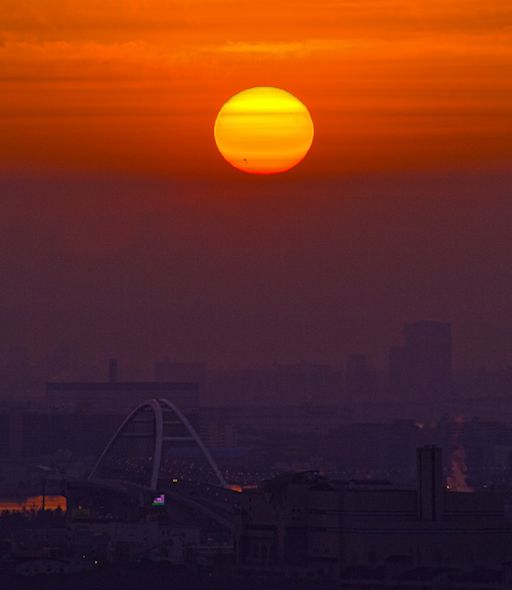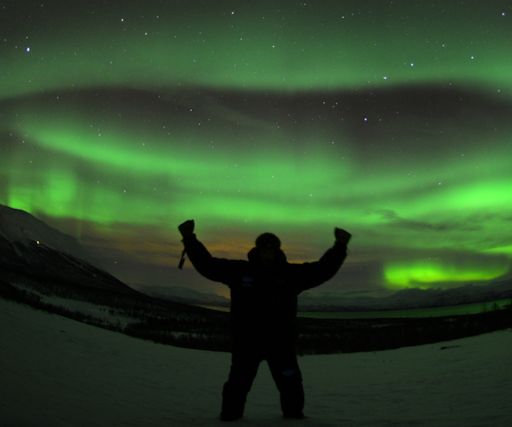When is the best time to see auroras? Where is the best place to go? And how do you photograph them? These questions and more are answered in a new book, Northern Lights - a Guide, by Pal Brekke & Fredrik Broms. | | | A SLIVER OF VENUS: Venus is turning its night side toward Earth as it approaches inferior solar conjunction on Jan. 11th. Less than 2% of Venus's sunlit hemisphere is now facing us, which means the planet looks like an incredibly slender crescent. If you have a GOTO telescope, command it to slew to Venus this evening. Be careful, though, because Venus is only 11o from the blinding sun. [photo gallery] GIANT SUNSPOT: Sunspot AR1944, which appeared on January 1st, is one of the largest sunspots of the current solar cycle. It's so big, people are noticing it as a naked-eye blemish on the solar disk. Daisuke Tomiyasu sends this picture from Higashinada-ku, Kobe, Hyogo, Japan: 
"Sunspot 1944 was visible at sunrise on January 4th," says Tomiyasu. "I combined three exposures of 1/15sec, 1/100sec, and 1/640sec to create this HDR (high dynamic range) image." Aside: Look carefully at the full-sized picture. There is a red fringe on the bottom of the sun and a green fringe on top. That's real. The colorful fringes are caused by refraction in Earth's atmosphere. The effect is explained here. Although the sunspot has been relatively quiet and stable since it first appeared on New Year's Day, a region of this size has the potential to produce significant activity. Indeed, NOAA forecasters, who say they are keeping a close eye on this behemoth, estimate a 75% chance of M-flares and a 30% chance of X-flares on Jan. 4th. Solar flare alerts: text, voice. Realtime Space Weather Photo Gallery GREEN VORTEX OVER SWEDEN: For the second day in a row, a solar wind stream is buffeting Earth's magnetic field, sparking intermittant geomagnetic storms and auroras around the Arctic Circle. Last night, Northern Lights tour guide Chad Blakley photographed a luminous green vortex over Sweden's Abisko National Park: 
"Tonight was one of those nights that makes being an aurora photographer the best job in the world," says Blakley. "The lights started around 5:00 PM and continued well into the night. I had the pleasure of spending the evening with Peter Richards, a representative of National Geographic student photography expeditions. At one point during our night under the stars I heard him say that the display was the most amazing thing he had ever seen in his life - I couldn't agree more!" NOAA forecasters estimate a 20% chance of more polar geomagnetic storms on Jan. 4th as the solar wind continues to blow. Aurora alerts: text, voice. Realtime Aurora Photo Gallery
Realtime Venus Photo Gallery
Realtime Comet Photo Gallery
Every night, a network of NASA all-sky cameras scans the skies above the United States for meteoritic fireballs. Automated software maintained by NASA's Meteoroid Environment Office calculates their orbits, velocity, penetration depth in Earth's atmosphere and many other characteristics. Daily results are presented here on Spaceweather.com. On Jan. 4, 2014, the network reported 35 fireballs.
(19 sporadics, 14 Quadrantids, 1 lambda Bootid, 1 December Leonis Minorid) 
In this diagram of the inner solar system, all of the fireball orbits intersect at a single point--Earth. The orbits are color-coded by velocity, from slow (red) to fast (blue). [Larger image] [movies] On Jan. 3, 2014, the network reported 27 fireballs.
(14 sporadics, 13 Quadrantids) 
In this diagram of the inner solar system, all of the fireball orbits intersect at a single point--Earth. The orbits are color-coded by velocity, from slow (red) to fast (blue). [Larger image] [movies] Potentially Hazardous Asteroids ( PHAs) are space rocks larger than approximately 100m that can come closer to Earth than 0.05 AU. None of the known PHAs is on a collision course with our planet, although astronomers are finding new ones all the time. On January 4, 2014 there were potentially hazardous asteroids. Notes: LD means "Lunar Distance." 1 LD = 384,401 km, the distance between Earth and the Moon. 1 LD also equals 0.00256 AU. MAG is the visual magnitude of the asteroid on the date of closest approach. | | The official U.S. government space weather bureau | | | The first place to look for information about sundogs, pillars, rainbows and related phenomena. | | | Researchers call it a "Hubble for the sun." SDO is the most advanced solar observatory ever. | | | 3D views of the sun from NASA's Solar and Terrestrial Relations Observatory | | | Realtime and archival images of the Sun from SOHO. | | | from the NOAA Space Environment Center | | | the underlying science of space weather | | 
